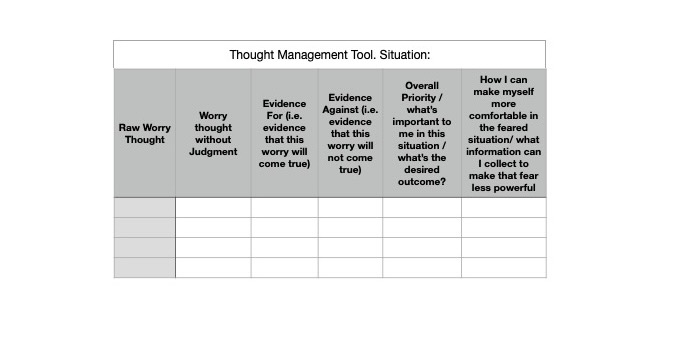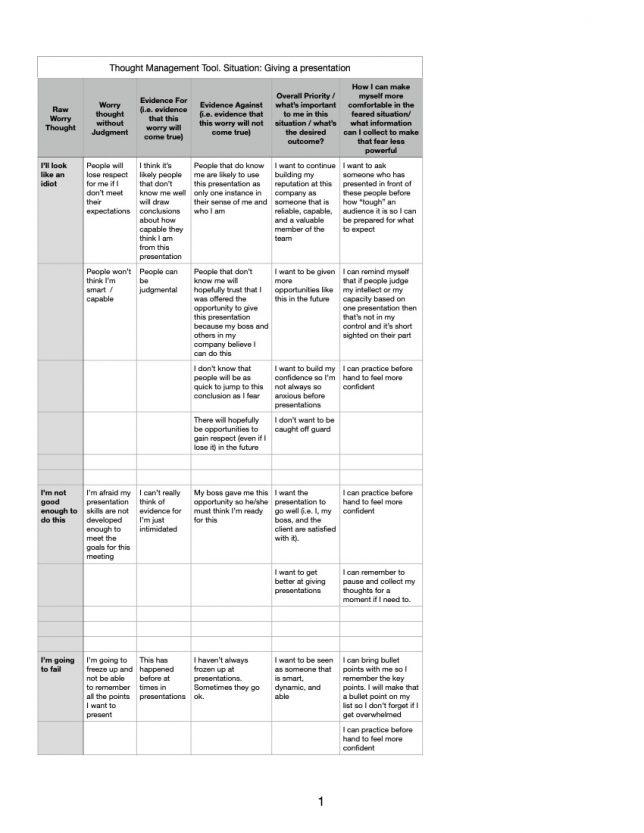- A simple, but transformative skill: learning how to be fully and wholly present in just one moment at a time.
- Learning “one mindfully” (as we call it in the DBT world) can reduce anxiety, improve concentration, increase our ability to handle a crisis, increase our ability to connect to our authentic selves, and increase our efficiency.
- The opposite of this concept is “mindlessness” (not fully being present with any activity – i.e. “going on autopilot”) or multi-tasking (attempting to do two activities at the same time).
- The most common way many of us “multi-task” is something most of us would not identify as multi-tasking: Thinking about one thing while doing another.
- Like the time you were in a meeting but actually preoccupied by the conflict you had the night before. Or, when you were writing an email while thinking about how to prepare for something later in the day.
- When we use one-mindfully we work to be present with our whole selves, which means paying attention to the content of the moment while also paying attention to internal cues about our experience of that moment.
- We set an intention for what we will focus our attention and energy on, and we work to keep ourselves focused on that intention despite urges to split our attention, or give in to distraction.
- This does not mean that we cannot choose to change where spend our energy and attention or that we have to completely finish before shifting our attention; it means that when we change what we are doing (and where we are focusing) we do so with intention and awareness, even if we are right in the middle of something.
- This also does not mean we cannot transition quickly between tasks (think about cooking: you are chopping the carrots, then stopping to stir the onions). We can be wholly present with one activity while another in the background does not have our attention.
- This skill centers us, and requires that we recommit again and again to what we will spend our energy on in the face of distractions. It also requires that we reassess as time goes on to determine if we want to continue recommitting to that moment, or to changing where our focus will be.
Most of us struggle fairly significantly with “doing” one thing at a time. This is because many of us are “doing” one thing, but thinking about another. In this way, we’ve become accustomed to leaving the present moment for one in the past, one in the future, or one that may never happen. When we do this we reduce our ability to concentrate by dividing our attention. We also decrease the likelihood we will pick up on important cues from the environment around us; when we are distracted we are not able to be as perceptive.
In simple terms this skill is “doing” one thing at a time, but more complexly it is devoting your attention and energy to only one “thing” at a time. As Marsha Linehan says, this means, “When you are thinking, think. When you are worrying, worry. When you are planning, plan. When you are remembering, remember. Do each thing with all of your attention”. Dialectical Behavior Therapy, and Marsha Linehan, would encourage all of us to spend as much time as possible being wholly present with whatever moment we are engaged in.
Many of us are spending large chunks of our time distracted, and not present in both mind and body in whatever moment we are in. To be wholly and fully present means paying attention to your outer world (i.e. the conversation you are in) and your inner world (your internal reactions to that conversation in your thinking, feeling, and sensing). Although it sounds simple enough, it is actually a lot of input to pay attention to at any given point in time and takes some practice straddling both your inner and outer worlds simultaneously.
One-Mindfully can be a powerful grounding and centering tool because it focuses us simply on the moment we are in. A common treatment for trauma, anxiety, and depression is learning how to be in and stay in the present. Like any new skill, I encourage folks to try this first in “low stress” situations (i.e. ones that are not likely to incite a lot of activation in your inner world) before high stress situations (i.e. ones where you expect to have a lot of thoughts, intense feelings, or intense sensations).
See comments for more on this skill including ideas for how to implement it today.
Comments:
- Often, I see this struggle to be “one mindful” in the way many of us manage our relationships with our computers during the workday. Does this sound familiar: “You’re writing an email and you get a pop-up notification that you’ve gotten a calendar invite. Without even thinking you stop writing the email, review / accept the calendar invite, and then try to return to your email. But wait, now you lost where you were and so you re-read your last sentence, get back in the mindset of the the response and boom, an instant message comes in asking you if you saw the most recent email from so-and-so about this-thing or that-thing. So you scroll to the top of your inbox and read the email, respond to the instant message but wait now you can’t find that email you just had opened. Ok, you found it. But wait what were you saying, and ok now there is only 5 minutes left before the next thing on your calendar and somehow you haven’t gotten to that response yet. Now you feel this anxious pressure to get it out, but you are also aware this isn’t the quality response you wanted to send out so now you have to decide if it’s more important to get it out quickly or thoughtfully…etc”. Multiply that experience throughout your day and your day ends with you feeling frazzled, unproductive, behind, like you’ve missed a bunch of things and like you’ve been ping-ponging around all day. And that’s because you have! All those notifications are very stimulating and they are prime ways in which we forget to insert that intentionality into our decision about where we spend our time and attention when we are with our devices. One low-stress way to start trying to introduce this skill into your life is by bringing thoughtfulness to what notifications you need on, and how you respond to those notifications when they are on. As Marsha Linehan might say, “When you are writing an email, write the email.” If you find you are tempted to be distracted by your phone turn it over or put it on silence. If you are expecting to hear from someone important while you write, work to make yourself accessible in a way that will not distract you (i.e. ask them to call you, or silence texts from other people except that one person). Setting up a routine that enables a mindful perspective can take some work, but it should help improve concentration and productivity and leave you feeling better at the end of the day.
- Back when therapy was always in an office you were forced to take a one-mindful perspective with your session. You didn’t have a screen, or your phone handy and the temptations to engage with something outside the content of the session were much less accessible. If you are doing remote based therapy try and re-create the in-office experience as much as possible by eliminating the possibility of something outside of the session distracting you away from being fully in the session.
- If you are someone who commonly multi-tasks or operates in a “mindless” manner, it will take time time and deliberate practice to bring a more “one-mindful” stance to how you spend your time. For tips on how to bring this concept to your life at a pace that works for you, see my post on how to sustainably make long-term changes.
- This concept / skill is kind of like living your life in real time meditation, albeit a meditation where you are responsive to your environment. Like our meditative practice, your mission throughout is to regularly bringing your attention back to your chosen focal point. For an introduction to meditation, and this concept of returning to a chosen focal point, see my introduction to meditation post (which has more direct parallels to today’s post), and my post on general meditation.
- Sometimes we find that we can’t control our attention. That’s ok. No one is perfect at this. Sometimes we are coping best by accepting what is not within our control, and often times what is out of our control is content of our inner worlds. (If you struggle with this concept this post on acceptance might help). This can mean the thought, feeling, sensation, or external circumstance arising is too distracting or powerful to redirect yourself from (i.e. you just got news of something upsetting and of course you can’t focus on your previous intention). At that time, it can be helpful to view that as a cue that you need to switch your attention over for a period of time, even if you don’t want to. A powerful way in which you can stop ruminating (when you can’t stop thinking about something) is to set a timer for ten minutes, and just be with the worry. After ten minutes, when the timer goes off, you may find it’s easier to redirect your attention back to a different focal point. After ten minutes of really fully devoting yourself to it (instead of having it simmer in the back of your thoughts for hours at a time where you ping pong between thinking about that and all the other things in your day) you may have found a solution, or exhausted all the different ways you can think or worry about something, but either way it’s more likely to feel less pressing. There are other skills to combat intrusive worries for another day.
- Regarding the idea of perfection – it is not realistic (or even the goal) to exclusively live in a “one mindfully” stance. Sometimes we do want or need to split our attention and that’s OK. The key is to selectively and with awareness choose to do so, and to use one mindfully with more important tasks.
- A little more on identifying and understanding multi-tasking. There are three ways of multi-tasking: attempting to do one activity while you think about another activity (sitting in your meeting and thinking about that conversation you had last night), attempting to think about two things at the same time (going through the grocery list while you try and plan out that email to your boss), or attempting to do two things at the same time (talking to your friend and scrolling on your phone). A one-mindful perspective would encourage you to limit each as much as possible.
- If you find yourself regularly tempted to split your attention or “zone out” start trying to pay attention and get curious about it. Sometimes there is a lot we can learn about what we are trying to distance ourselves from when we pull our full attention away in these ways.
- Marsha Linehan’s skills, including one-mindfully, are outlined in full in her skills training manual and associated skills training workbooks.



